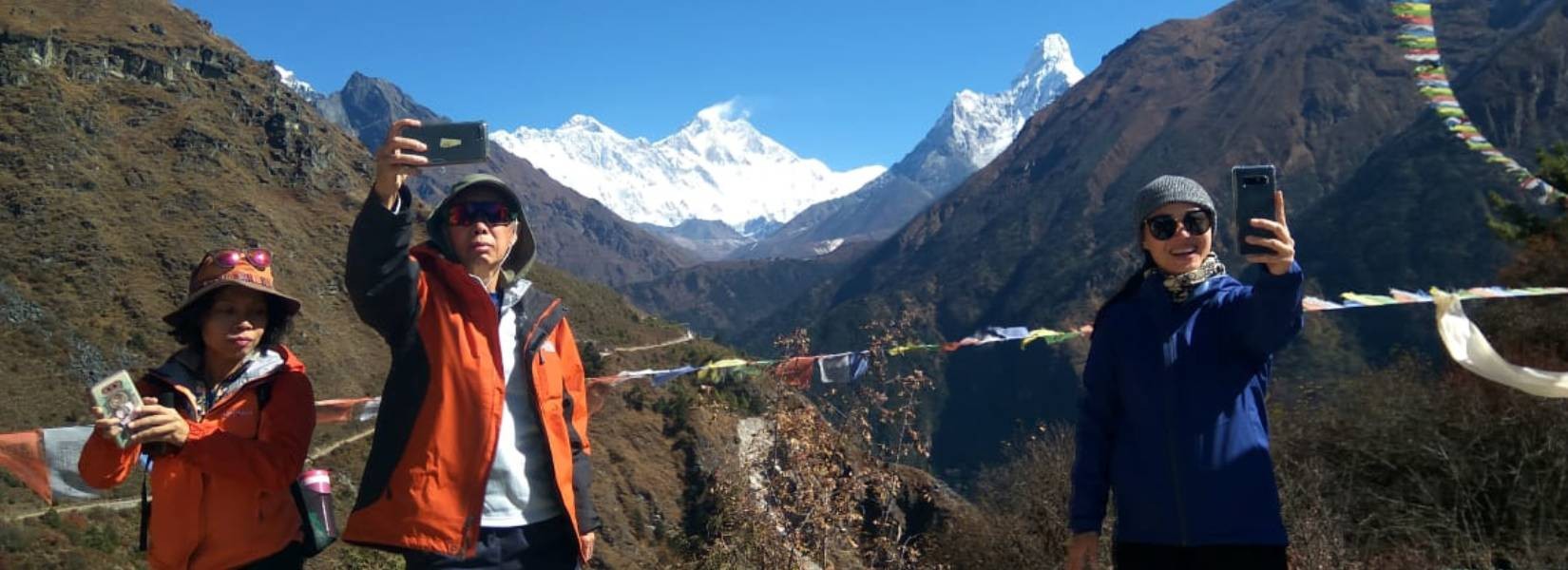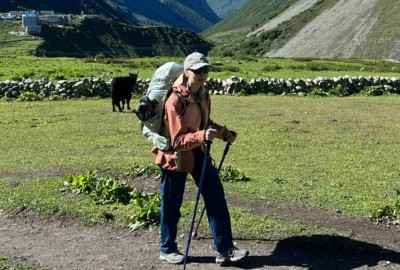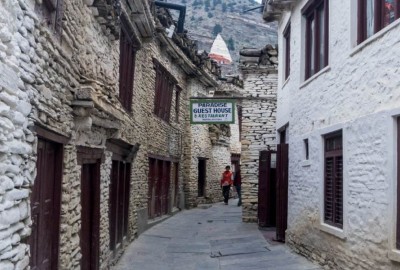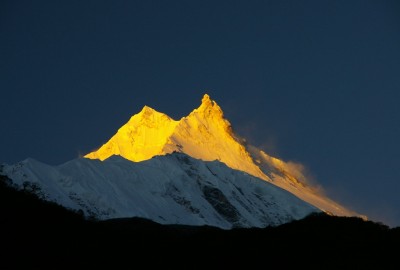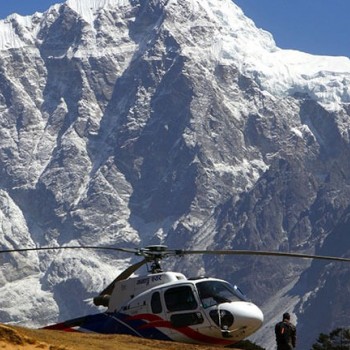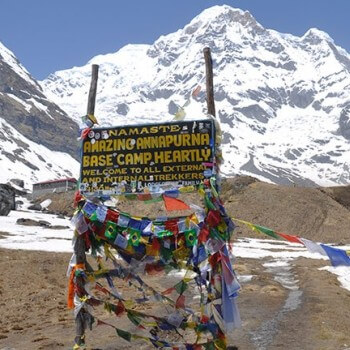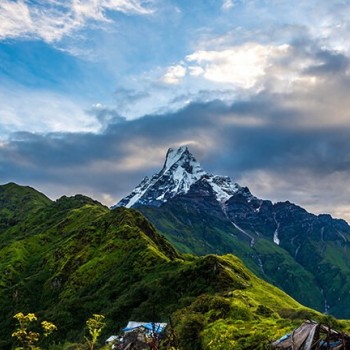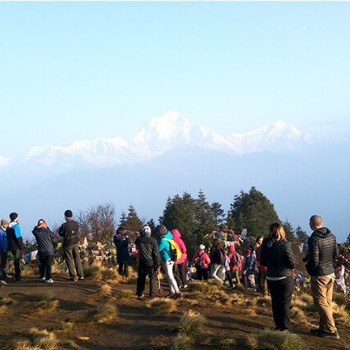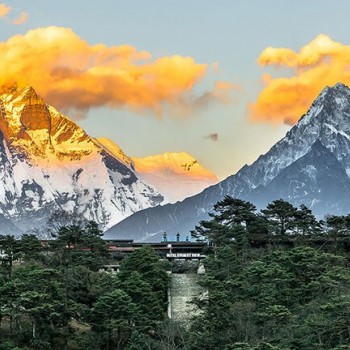Trekking can be an exhilarating experience for everybody but a lot of the time it requires a good deal of physical strength. Often Treks in Nepal are not ideal for senior citizens and tourists. However, if you are in the finer ages of your life and you still long for the experiences you have during trek then here are some locations that suit you the best.
Table of Contents
Plan your trip to Nepal
Customize your trip with help from a local travel specialist.
Everest View Trek
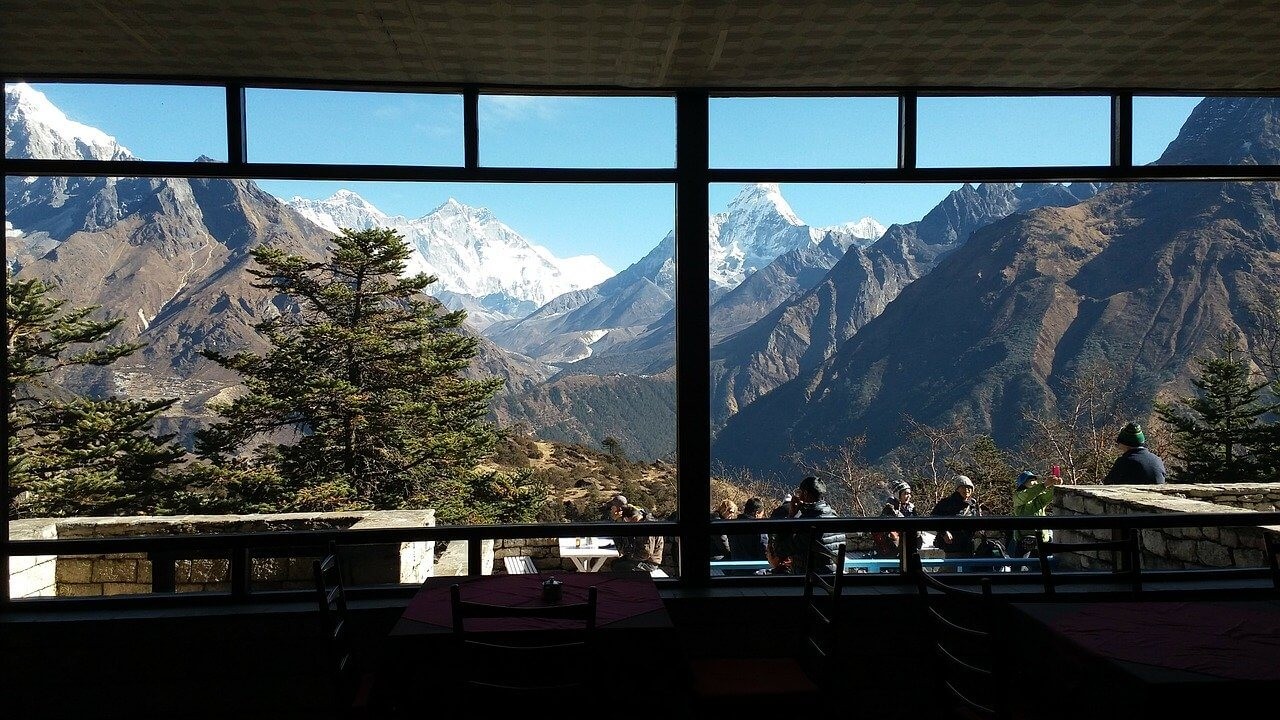
Ending with an ascent of a foothill of Everest, this trek follows the footsteps of Tenzing and Edmund Hillary. Compared to other trekking trails in the Everest region, this trek is comparatively easy and can be done in 5 days in all seasons. Although this trek is comparatively easy, it is one of the most phenomenal trekking routes in the Everest region. Located inside the Sagarmatha National Park, this trek familiarizes you with Sherpa villages and introduces you to their culture. It also provides an excellent view of the world’s tallest mountains including Mount Everest, Lhotse, and Cho Oyu. Designed for people who do not wish to ascend high altitude, this place is perfect for seniors.
Best Time To Go Everest View Trek
Spring which starts from March and ends in May or Autumn starting from October and ending in Nepal is regarded as the best time to go on this trek. During these times, the weather is very clear and the mountain views will not be veiled by the clouds. As the weather is ideal, you will be able to acknowledge the beautiful landscapes and mesmerizing mountains. While December is regarded as one of the best times to trek through these trails, it does have some drawbacks.
During December, the highest altitude you will get to is 12,500 feet which is when you travel to Tengboche Monastery. As December is considered as one of the colder seasons, for the safe region you should travel in the lower elevation. There is no possibility of extremely bad weather conditions like snowstorms if you trek under 4,000 meters. The short number of days it takes to complete this trek and the marvelous views of mountains are the primary reasons first-time trekkers in Nepal choose this trek. With an abundance of rest stops along the Everest Panorama Trek route, you can walk at your own leisure. You can also visit this trail any time of the year although it might be a little difficult during Summer and Winter.
Of all trekking routes in Nepal Himalaya, the most famous trek is the Everest Trekking Package. In the Nepalese Himalayas, the Everest trek is the most demanding route and Nepal’s number first the most popular. Located at an altitude of 18,205 feet, the Kala Patthar hike gives you the best viewpoint for watching the Khumbu Himalayan range. And with an experienced trekking guide by your side, you can delve into the base camp.
Entry Point of Everest View Trek
The gateway to exploring Everest is either Lukla or Phaplu. Moreover, while trekking to Gokyo valley you can hike to 5th Gokyo Lake or Cho Oyu base or 4th Gokyo Lake. In the west the Gokyo glacier lake and in the eastern side, the Everest base is connected by Chola pass at an elevation of 18,204 feet.
The Everest base camp is situated in the eastern part of Kathmandu.
With a diverse culture and natural landscapes ranging from flat land in Terai to the high hills of the Himalayas, Nepal albeit small is a self-contained package. It is also known as the birthplace of Lord Buddha and the place where the tallest mountain, Mt. Everest, stands with a height of 8848 meters above sea level. In terms of the demands of visitors, the most popular trekking routes are Everest Three High Pass Trek, Renjola pass trek, Gokyo Cho La Pass Trek, Kala Patthar trek, Everest Base Camp Trek, and Gokyo Ri trek.
Jomsom Muktinath Trek
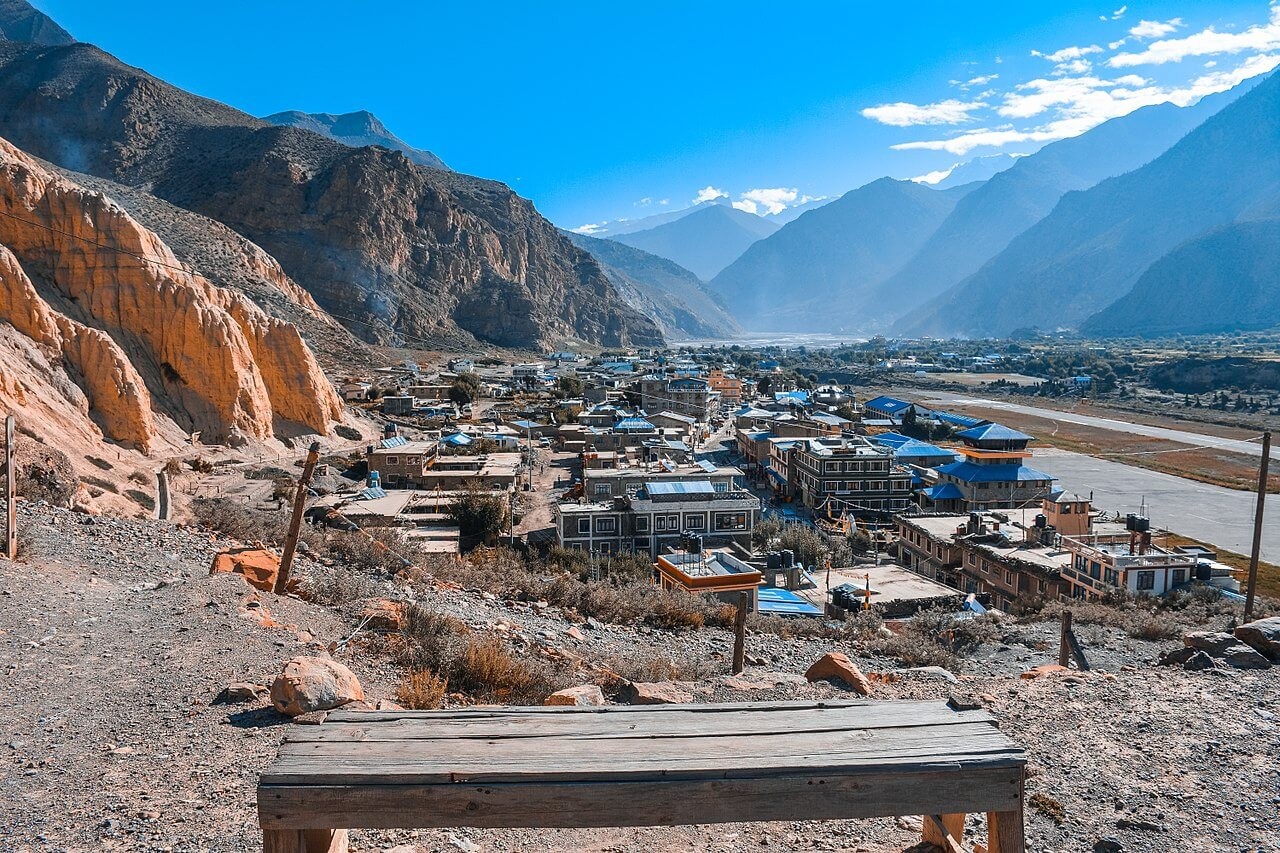
Along this trek, you can get an insight into the way of life of various ethnic groups of Nepal. You can also see the diverse landscape and culture this place has to offer. The deepest gorge created by the Kali Gandaki River is the primary attraction of this place which flows into the Ganges in India and originates in the Tibetan plateau.
A popular pilgrimage site for Buddhists along with Hindus, called Muktinath, is not too far from Jomsom. Muktinath is a sacred place of salvation to the Hindus who believe that bathing in the water here guarantees salvation after death. Hindus believe that God Brahma lit the eternal flames that burn at Muktinath. According to Buddhists, the great sage Guru Rinpoche came to meditate in Muktinath. Buddhism was brought to Tibet by Padmasambhava (Guru Rinpoche). Fossilized ammonites known as Shaligram can be found along the upper reaches of the Kali Gandaki.
Highlights of Jomsom Muktinath Trek
Gurungs and Magars inhibit the lower region of Kali Gandaki, around Muktinath and up in Mustang, you can find the Lopa who are people with strong Tibetan roots and the Thakalis are around Jomsom. For those who wish to see the different customs and attire as well as the diversity of the ethnic group, this trek is ideal for them. In the upper region, Tibetan Buddhism is the dominant religion while Hinduism prevails in the lower region. In early September in Muktinath, one of Nepal's unique festivals named Yartung (annual horse race) is celebrated. It has some serious Tibetan style horse racing as well as merry-making.
Jomsom Muktinath Trek Route
The routes along Jomsom form a part of the Annapurna Circuit and Annapurna foothills treks. The usual starting point is from Pokhara’s NayaPul to Baglung road and from there through Ghorepani and Tatopani into the gorge of Kali Gandaki. There is a drastic change in scenery between Tatopani and Lete Khola. An abundance of pine forests can be found along the trail while villages take on a different appearance. The layout of the villages and the design of the houses are quite unique to this area. The way the houses are built are meant to withstand the strong winds that start from the late morning protects its inhabitants every day.
The difference in atmospheric pressure between the Tibetan plateau and the lower reaches of the valley causes the wind. A two-hour walk down from Jomsom is Marpha which gives an example of the unique architecture of this region. Marpha is an excellent place to rest in as it has flat-roofed houses that have a central courtyard and stone flagged streets with the drainage system. During your free time, you can taste the products that are grown in the orchards.
Transportation and Accommodation in Jomsom Muktinath Trek
With regular flights that come to Jomsom from Pokhara, Jomsom is mostly known for its airport which offers a quick exit and entry to the valley. The flights are prevented from taking off after 11 a.m. by the strong winds. If you want to explore the upper part of the Kali Gandaki region then you can use Jomsom as a base. In Jomsom, nowadays you will be able to find plenty of accommodation as well as a new high-class resort complex that has opened there. An alternative to Jomson as a base for the trek is Kagbeni which is a two-hour trek up the valley. Kagbeni is quite serene as it is not as hectic as Jomsom is. Kagbeni is the furthest you can trek without a permit and an accompanying Environmental Officer.
Mardi Himal Base Camp Trek
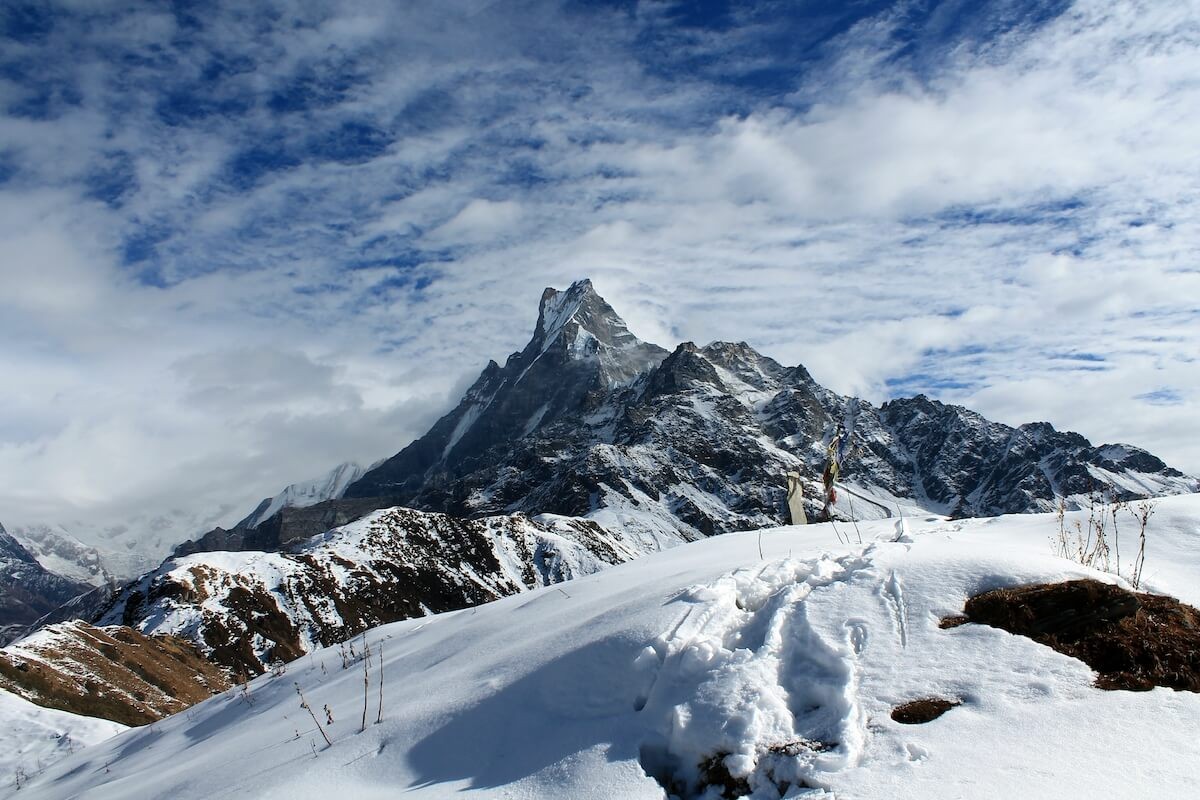
Located on the East side of the Annapurna Base Camp trek, Mardi Himal is a hidden gem. There are few trekkers who trek to Mardi Himal Base Camp located at the base of Mardi Himal and Machhapuchhre. In this trek, you will walk through enrapturing rhododendron forests along small winding paths before finally climbing out of the forest at an elevation of approximately 3,300 meters. The landscape changes suddenly into a rocky high mountain landscape which gives stunning views of the Machhapuchhre, Hiunchuli, Annapurna South and Mardi Himal. In about 3 to 4 hours you can climb up to Mardi Base Camp from high camp (3700 meters) which offers a breathtaking closeup view of the whole Annapurna range. There are plenty of homestays and guesthouses along the entire trail route.
Best Time To Go Mardi Himal Trek
The best time to go trekking is in Autumn and the best months are Mid-September to October. Other peak times are from March to May and December to February. From December to February, the skies are clear but there is a risk of passes being closed due to snowfall as it gets very cold. Nepal’s hot, pre-monsoon season is between May to June and it can get very warm. If you do not mind the warmth then in the trail route you will see many flowers that have started blooming and green leaves coming up. Monsoon season is between June to Mid September and it is regarded as an offseason.
During these months, the risk of downpours and leeches greatly increase and as you have to walk through forested areas, leeches are quite active at this time of the year in Mardi Himal. If you are trekking here at this time of the year then it is recommended that you wear long trekking trousers and carry mosquito repellent spray.
Start and End Point of Mardi Himal Trek
The starting and ending of the Mardi Himal Trek are also in Pokhara like most of the Annapurna treks. Pokhara is situated 200 km west of Kathmandu and is the second biggest city. It is also an ideal place to relax after the strenuous treks in the Annapurna. There are several flights that go to Pokhara daily from Kathmandu through domestic airlines. The flight tickets are usually USD 110 to 125 per person. You can also opt to travel through a tourist bus. Prices of tourist buses usually start at around USD 10 to 25 and take about 7 to 8 hours to get to Pokhara from Kathmandu. The price of the tourist bus varies according to the services available on the tourist bus. Tourist buses usually leave every morning at 7 am. Another option is to travel through a local bus which runs till 3 pm and leaves every one hour from Kathmandu. Local buses are the cheaper option of traveling.
Total Days for Mardi Himal Trek
The Mardi Himal Trek usually takes around 9 to 10 days to complete among which 2 days will be spent traveling to and from Kathmandu to Pokhara while the rest is spent hiking. The Mardi Himal Trek can be combined with many other treks related to Annapurna. Most of the trekkers combine this trek with the Panchase Trek, Ghandruk Trek, Ghorepani Poon Hill Trek, etc. If you are short on time then you can take a domestic flight from Kathmandu to Pokhara and start the trek on the same day which ultimately shortens the number of days spent there. This trek is suitable for people with a moderate level of fitness and you do not have to be super fit to do this as this does not have direct climbing involved. However, near base camp and high camp, you will need to trek over some rocky sections. It is recommended that you consult a doctor before doing this if you have problems regarding altitude.
Mardi Himal Trek Cost
The cost of the Mardi Himal Trek depends on the accommodation, mode of transportation and tour. The prices usually depend on the tour plan and if you want the budget, deluxe or standard tour plan. It also depends on the number of people who are going and the time of the trek. While there are not many risks to this trekking, trekkers should be aware that they might experience unpredictable weather, extreme conditions and last-minute changes beyond anyone's control.
Annapurna Base Camp Trek
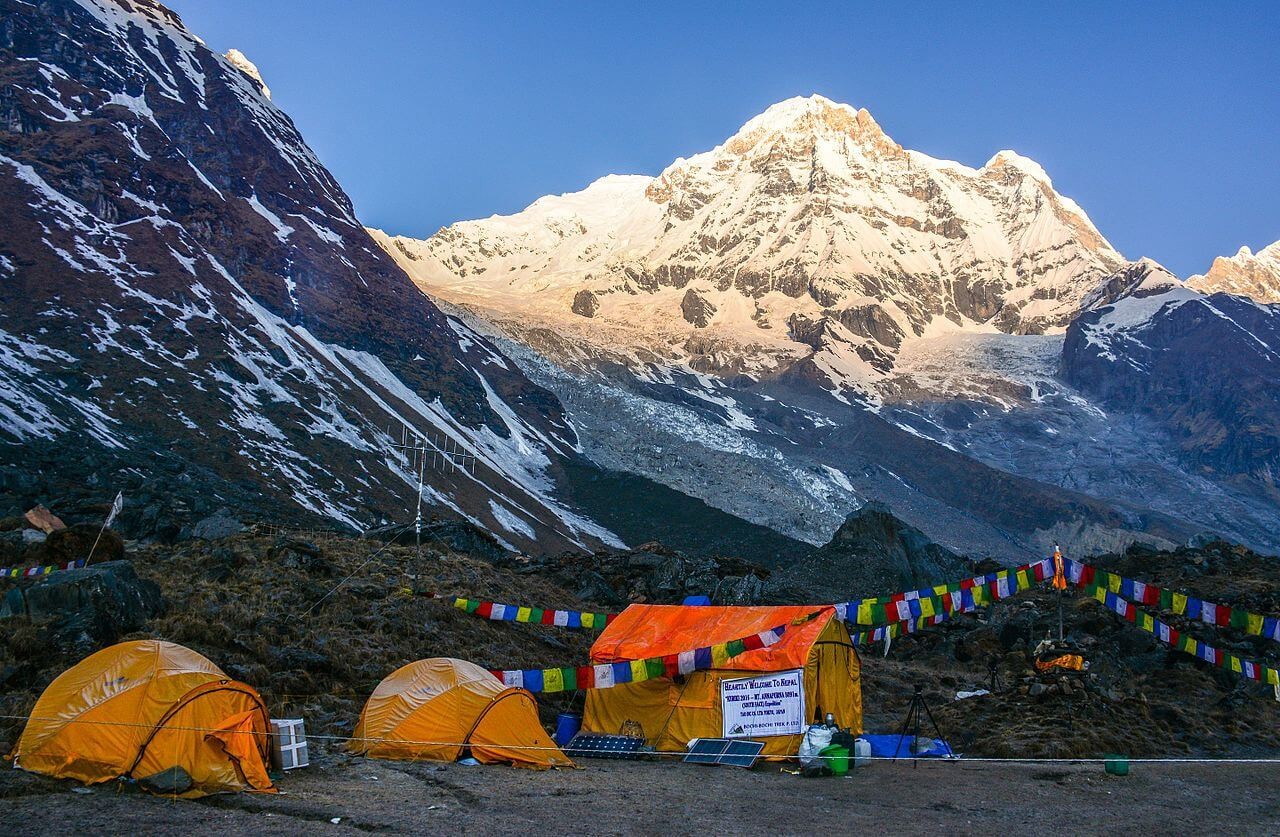
This trek is suitable for seniors only if you have trekking experience. The Annapurna Base Camp Trek is one of the few treks that takes you through many different landscapes and brings you close to the base of many 7,000 and 8,000-meter peaks in a short amount of time. Known as one of the most popular trekking places in the Annapurna region, this trail takes you into lush rhododendron forests, alongside terraced rice paddies and high elevated landscapes with the view of the Annapurna range being seen most of the time. At 4130 m, the background of Annapurna Base Camp is astonishingly marvelous and one of a kind. It is enclosed by the gorgeous peaks of Machhapuchhre (6993m), Annapurna I (8091 m), Hiunchuli (6441 m) and Annapurna South (7219 m). While the amount of time it takes to complete the trek depends on your itinerary and your pace, it is usually completed within 7 to 12 days.
Annapurna Base Camp Trek for Solo
The Annapurna trek can be done solo easily. While the trek can be done during any time of the year, it is better to not risk it during winter as it may sometimes be closed due to the snow level. There is also a risk of avalanches between Machhapuchhre base camp and Himalayan Hotel so you have to take caution. It takes 12 days to complete the trek with the itinerary presented here. Starting at a place called Nayapul which is an hour and a half drive away from Pokhara, this trek takes you up North to Ghorepani and Poon Hill. You go to Chomrong from there which is eastward of Ghorepani and then north again. You will then enter Modi Khola Valley which will lead you upwards towards the base camp.
Annapurna Base Camp Trek Route
The Nayapul-Ghorepani-Ghandruk-Nayapul circuit is the one most people trek through as it can be easily done by anyone, even children, and it is very rewarding. You have the option to return back through Jhinu Danda where you can relax your muscles in the hot springs. It is recommended that you visit one of the Gurung villages of Landruk or Ghandruk as it is valuable. The lodges in the Annapurna Trekking Region are well accommodated with a variety of foods in their menu which ranges from the typical Nepali Dal Bhat to Pizzas. You also have a hot water facility in case you want to take a shower.
Ghorepani Poon Hill Trek
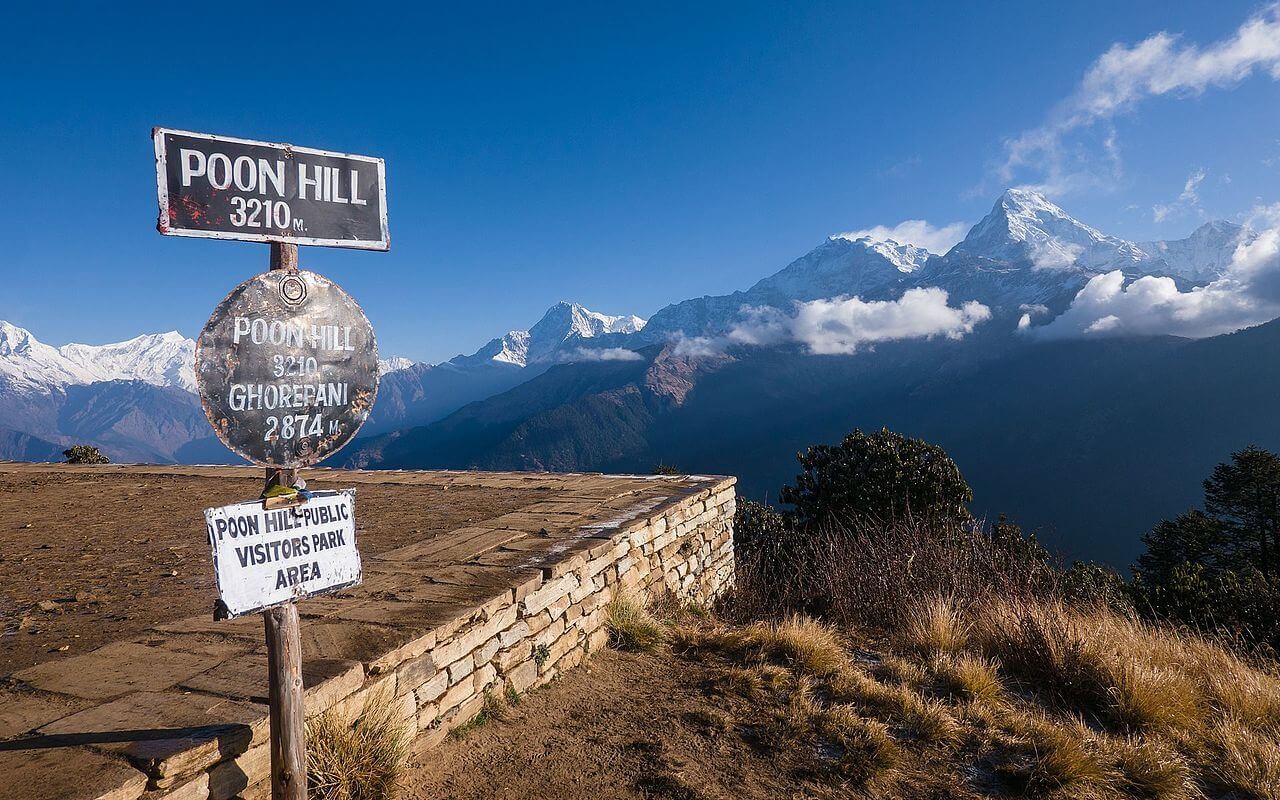
The Ghorepani Poon Hill trek is perfect for those who only have a limited number of days they get to spend in Nepal but wish to experience Nepal’s mountain culture and see the popular Himalayan range. This three-day trek basically gives a gist of what the lengthier Nepalese mountain trek will be like. During this trek, you will pass through peculiar villages and observe the unique local cultures of the Magar and Gurung communities.
Highlights of Ghorepani Poonhill Trekking
You will walk over rivers, pass through jungles and walk up many stairs before finally reaching an elevation of 3,200 meters. From here you will be able to see the panoramic views of some of the biggest and dazzling Himalayan mountains including Machhapuchhare, Dhaulagiri, Annapurna II, Nilgiri, and Lamjung. The starting point of the trek is just an hour and a half drive away from the lakeside town of Pokhara and as this is a short trek which will take you 3-4 days to complete, it is the perfect way to ease yourself into trekking.
Best Season for Poonhill Trek
The most ideal trekking season for this is between March to May and September to November. These months are perfect as the weather will be ideal and you will get to see the views of the mountains. Hiking during December and January is possible but the weather will be chilly as it will be winter and the temperature can drop below -15c during peak seasons. There will be an increase in possible wet days during May as it is the start of the monsoon season. If you trek to Poon Hill during April, then you will get to see the famous rhododendrons in full bloom and the weather is comfortable.
Total Days to Complete Ghorepani Poonhill Trek
While the amount of time it takes to complete the trek is listed as 4 to 7 days, it depends on the amount of time you want to spend there and the trail you follow. The most famous trail that people take is the one from Nayapul to Ghandruk. If you are not short on time then you can take the 5-day trek option and go through Tatopani and Ghandruk on the way back to Pokhara.
Ghorepani Poonhill Trek For Solo
Trekking to Poon Hill is possible both solo and in a group. The one which is ideal for you depends on you yourself. If you prefer to travel solo then you have the freedom to travel at your own pace, it is not that expensive and if you really want to be around people, you will find plenty of them at the tea houses but then again you will have to plan the whole trip and you might not know the way and get lost. Safety is also a priority and while Nepal is welcoming and notoriously friendly, you can never be sure.
For hiking in a group, you have the option to either hire a guide or go in a group. If you hike in a group when everything is organized for you, you will have local expert knowledge, porters to carry your heavy gears and taking a guide with you empowers the local community. The downside to a group is the increase in cost and the lack of flexibility.
Poonhill Trek Permits
For trekking to Poon hill either solo or with a group, you will need to acquire an Annapurna National Park Permit also called the Annapurna Conservation Area Permit as well as Trekking Information Management System (TIMS) permit. If you have hired a trekking company then the cost of the permits will be added into your trekking fees and will be managed by your tour guide. The TIMS Permit costs about USD $20 or NPR 2,000 per person and the ACAP permit costs NPR 3,000 or USD $30 per person. The permits will be checked at various points along the trail so they need to be carried along at all times. The permits can be acquired either in Pokhara or Kathmandu in Nepal Tourism office.
Ghorepani Poonhill Trek Cost
Compared to some of the lengthier treks in Nepal, Poon Hill trek is comparatively cheaper. The starting price of the trip is usually about USD $240 per person although the cost depends on the season you are going in and the places you book. At USD $240, you will most likely get accommodation, 3 meals as well as drink breaks per day, a guide and a porter, taxis to Pokhara to the starting point and for Pokhara from the ending point and the required permits. Traveling without a guide or solo will cost less as you will not be paying for the guide and porter. There is also an entrance fee of NPR 100 at the entrance gate.
Everest Base Camp Trek
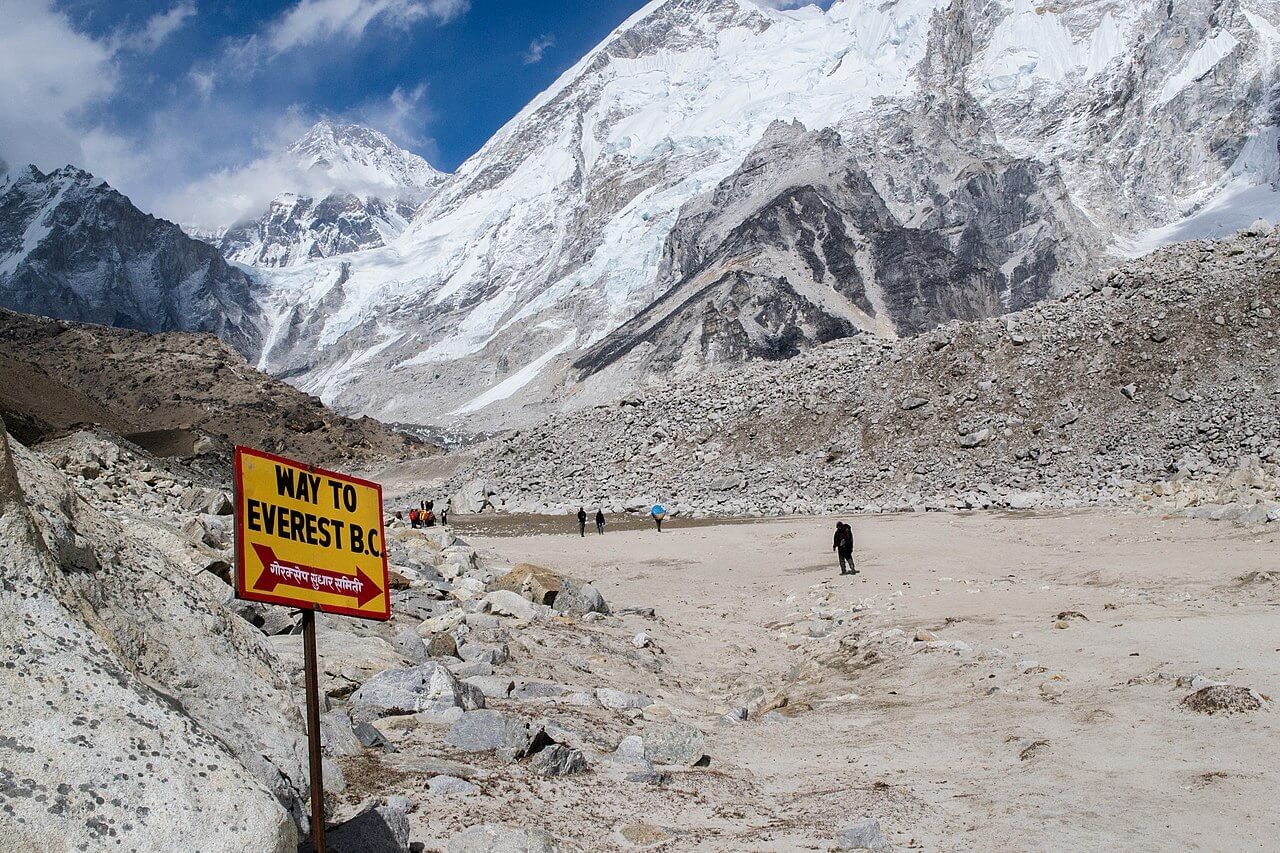 Image Source: Daniel Oberhaus
Image Source: Daniel Oberhaus
This trek is suitable for seniors only if you have trekking experience. Everest Base Camp trek is quite high in the priority list for trekkers. The starting and ending point of the two-week trek is Lukla which is an airstrip located in the south of the region. To begin the trek, trekkers usually fly to Lukla.
Trek Route to Everest Base Camp
To get to the popular Namche Bazaar, you have to take two days of the light trek up Dudh Koshi starting from Lukla. Numerous teahouses can be found along the way. On the first day, Monjo and Phakding are popular stopovers. The entrance to the Sagarmatha National Park beyond Monjo at Jorsale checkpoint where permits are checked. You will reach Namche Bazaar in 3 hours if just a few minutes away from Jorsale you start walking uphill from the suspension bridge. To get used to the change in surroundings, it is highly recommended that you stay there for a few days.
The trail leads to the valley of Imja Khola after leaving Namche Bazaar which gives gorgeous views of Kangtega, Thamserku and Ama Dablam mountains while the skies are hidden between the Lhotse and Everest. Tengboche is the most well-known rest stop after Namche. Until Dingboche or Pheriche is reached, the trail descends through Pangboche.
Trekking Duration for Everest Base Camp
It takes approximately 6 hours to walk from Pheriche to Lobuche which sits on Khumbu glacier's lateral moraine. From Lobuche, it takes 3 hours to get to the Gorakh Shep settlement. There are few tea houses there that provide accommodations. To get good pictures of the mountains, you can go to Kala Patthar which is located above Gorak Shep. To reach base camp, it can take a 5-hour long trek along the glacier. The risk of falling is there as the road is slippery so it is important to be extremely cautious.
Need Help Planning a Trip to Nepal?
Feel free to contact us, if you need any help planning your trip to Nepal. Our local travel experts will design a custom-made itinerary based on your time, group, cost, and other requirements.

